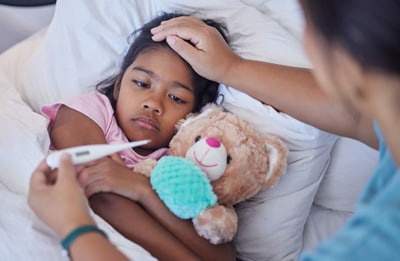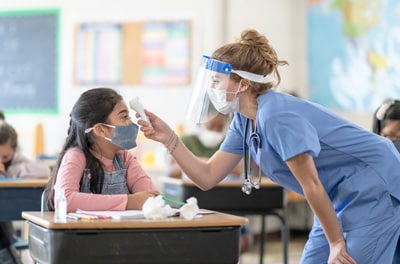Key points
- To slow the spread of infectious diseases, schools can encourage sick individuals to stay home, establish clear return-to-school policies, and provide personal protective equipment for staff.
- Schools must develop policies for common illnesses, balancing health needs with the educational and social needs of students.
- Review the provided information to understand policies and practices for effectively managing illness in schools.

Expectations
Schools can expect that children and staff will get sick during the school year. In a recent survey, more than two-thirds of children missed at least one day of school for illness or injury in the previous year. About half of those students were absent 1–3 days (National Survey for Child Health, 2022). When children or staff do get sick, schools can implement strategies to help slow the spread of infectious diseases, including:
- Staying home when sick.
- Knowing when to return to school.
- Using personal protective equipment for staff caring for sick children.
Staying home when sick
Under routine circumstances, school communities can expect some illness to spread. In general, children with improving symptoms should be able to participate in school.
If a child's needs while sick disrupt school staff's ability to teach and care for other students, the child should remain at home. Schools must balance the risk of disease spread with children's educational, social, and mental health needs when determining when students should stay home.
When children present with symptoms, schools, parents, and caregivers often do not know what specific illness a child may have. The following symptoms could affect a student's ability to participate in school and may indicate a risk of spreading infection to other students and staff:
- Fever, including a fever with a new rash
- Vomiting more than twice in the preceding 24 hours
- Diarrhea that causes 'accidents,' is bloody, or results in greater than two bowel movements above what the child normally experiences in a 24-hour period
- Skin sores that are draining fluid on an uncovered part of the body and are unable to be covered with a bandage
- Respiratory virus symptoms that are worsening or not improving and not better explained by another cause such as seasonal allergies
If a student has any of the above symptoms, they should stay home.
The above list describes symptoms of common illnesses experienced in school-aged children and can also apply to school staff. Schools should develop policies for common illnesses, such as strep throat and hand-foot-mouth disease. They should base these policies on CDC pathogen-specific guidance and seek assistance from school health teams and other professionals with expertise in infectious disease management. Teams can include people with child-health and infection-prevention expertise, such as school nurses, pediatricians, and health department advisors.
When developing illness-specific policies, schools can reference resources from school health experts, such as the American Academy of Pediatrics, the National Association of School Nurses, and the School-Based Health Alliance. Schools can also refer to state and local health department school health resources.
Return to school
When a person can return to school depends on the nature of the illness. In general, a child returning to school should be well enough to participate in school. For example, the child should be able to adequately manage improving cough and congestion independently and not feel overly fatigued. Care for the returning child should not interfere with school staff's ability to teach or care for other students.
Students and staff returning to school following an illness may still be contagious but are likely to be less contagious as symptoms improve, depending on factors like length and severity of illness. Parents and caregivers should consult their child's healthcare providers with specific questions about their child's condition or recovery.
For the general symptoms described in the "Stay at home when sick" section of this guidance, policies can allow a child to return to the school setting when:
- The child has not had a fever (and is not using fever-reducing medicine) for at least 24 hours.
- Fever with a new rash has been evaluated by a healthcare provider and fever has resolved.
- Uncovered skin sores are crusting, and the child is under treatment from a provider.
- Vomiting has resolved overnight, and the child can hold down food/liquids in the morning.
- Diarrhea has improved, and the child is no longer having 'accidents' or is having bowel movements no more than 2 above normal per 24-hour period for the child. Bloody diarrhea should be evaluated by a healthcare provider prior to return.
- Respiratory virus symptoms are getting better overall for at least 24 hours. Students and staff returning after a respiratory illness can consider additional actions to reduce spread.
State and local health departments may provide additional guidance on staying home when sick and considerations for returning to school after certain illnesses. Schools should refer to those policies alongside this guidance. There may be instances when schools adjust illness exclusion procedures due to community disease spread. For example, during an outbreak, a pandemic, or a period of excessive absences due to respiratory or gastrointestinal illness, schools may need to take specific actions. Schools can describe these instances in their emergency operations plan (EOP) as part of a layered approach to preventing disease spread. Schools can also work in coordination with health departments and school health advisory teams to develop these plans.
Schools can establish policies and practices that encourage students and staff to stay home when sick, ensuring that employees and families are aware of and understand these policies. In accordance with applicable laws and regulations, schools could:
- Allow flexible, non-punitive paid sick leave policies and practices for staff.
- Set policies to accommodate individuals who are sick and avoid incentivizing coming to school or work while sick.
- Support children who are learning at home because they are sick.
Schools should carefully consider requirements for families to obtain notes from a healthcare provider for illness-related absences. Parents can manage many common childhood illnesses at home. Requiring visits solely to obtain a provider note can create undue burden on families and the healthcare system. For example, caregivers might need to take additional time off from work or pay extra co-pays for these visits. Such requirements can disproportionately impact vulnerable populations and discourage illness-related absences.
Use of personal protective equipment

School staff who are assigned to care for sick children or who may be exposed to infectious materials should understand how to select and use the right personal protective equipment (PPE). PPE is equipment worn to minimize exposure to infectious materials that may cause illness. PPE includes items like gloves, safety glasses, masks or respirators, and gowns. For protection from infectious diseases, schools should make PPE available for staff to use when they expect possible exposure to infectious materials, such as when caring for a sick student or cleaning up used tissues or vomit. School health staff, such as school nurses or school-based health center personnel, should follow guidance intended for healthcare settings, such as CDC's Core Infection Prevention and Control Practices for Safe Healthcare Delivery in All Settings.
